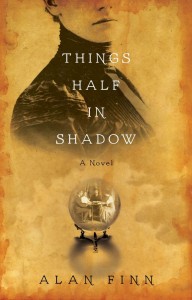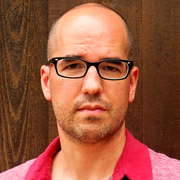Things Half in Shadow: Alan Finn on Spiritualism in Post-bellum Philadelphia
by Bethany Latham
 Philadelphia, 1869. Former soldier Edward Clark has survived the devastating Civil War so many others didn’t, and now he’s an independently wealthy young man who makes himself useful by working as a crime reporter. Edward lives well and has hit a trifecta with his fiancée: she’s rich, kind, and attractive. Things are going swimmingly until he’s given an assignment to write a series of articles debunking the city’s spiritualists — fake mediums defrauding grieving families. It turns out that Edward has secrets of his own, and when one of these mediums, the beautiful and cunning Mrs. Lucy Collins, discovers them, Edward is blackmailed into joining forces with her. Discrediting Philadelphia’s other mediums is just fine with Mrs. Collins, since she can then fill the vacuum left by her disgraced competitors and rake in the profits. Edward and Lucy face bigger problems, however, when a medium they cannot debunk is murdered at a séance they’re attending. Could she possibly have been the real thing? With everyone in the room a suspect, Edward and Lucy attempt to clear themselves by unmasking the real culprit…before both their lives are ruined.
Philadelphia, 1869. Former soldier Edward Clark has survived the devastating Civil War so many others didn’t, and now he’s an independently wealthy young man who makes himself useful by working as a crime reporter. Edward lives well and has hit a trifecta with his fiancée: she’s rich, kind, and attractive. Things are going swimmingly until he’s given an assignment to write a series of articles debunking the city’s spiritualists — fake mediums defrauding grieving families. It turns out that Edward has secrets of his own, and when one of these mediums, the beautiful and cunning Mrs. Lucy Collins, discovers them, Edward is blackmailed into joining forces with her. Discrediting Philadelphia’s other mediums is just fine with Mrs. Collins, since she can then fill the vacuum left by her disgraced competitors and rake in the profits. Edward and Lucy face bigger problems, however, when a medium they cannot debunk is murdered at a séance they’re attending. Could she possibly have been the real thing? With everyone in the room a suspect, Edward and Lucy attempt to clear themselves by unmasking the real culprit…before both their lives are ruined.
The choice of Philadelphia during this period is a robust one for a setting, providing a wealth of options for historical detail. Alan Finn, author of Things Half in Shadow, says the City of Brotherly Love has “such a rich past that it felt like the perfect place for a story involving mystery, history and spirits. As Edward writes in the book, ‘Wherever the past piles up, layer after dusty layer, ghosts are sure to linger.’ As a bonus, it also has quite a history of Spiritualist shenanigans. Because it was known as the Quaker City and had a reputation for religious tolerance, it seemed to draw charlatans and believers in equal measure.”
The novel explores several interesting locations in post-bellum Philly, among them the Eastern State Penitentiary, the Fairmount Water Works, and Christ Church Burial Ground, where notables such as Benjamin Franklin enjoy their eternal rest. Finn notes that it wasn’t difficult to get a feel for the place: “Philadelphia is a well-preserved city. Many of the locations used in the book are still there and open to visitors. For everything else, I relied on old newspapers, history books and a fantastic guidebook for visitors written in the 1800s. There’s also a wonderful website that features Philadelphia maps dating back hundreds of years. That was extremely helpful in learning the city’s geography during that time.”

Alan Finn is the pen name of an acclaimed author of mysteries and thrillers who has worked as an editor, journalist, and ghostwriter. He lives in Princeton, NJ, USA.
While the setting is evocative, Spiritualism takes center stage here, and plays a key role in the plotting of the novel. The Victorians have long been noted for their obsession with death, and Finn discusses the corollary rise in popularity of the Spiritualism movement: “Spiritualism had a relatively short heyday — about 80 years or so. But it was a fascinating movement in so many ways. There’s the theological aspect, in which upstanding, God-fearing men and women looked for answers beyond what Christianity had to offer. There’s a sociological aspect in terms of fads and frauds and large swaths of the public believing something that most of us would scoff at today. Then there’s the supernatural element: Were some of those mediums truly able to commune with the dead? Can spirits really contact us from the Great Beyond?”
The Victorian era was intriguing to Finn primarily because it was a period of great change, and thus great possibility. But there was also an undercurrent of darkness: “So much was happening in science, industry and society. Anything seemed possible. Yet life spans were still alarmingly short, compared with today, and in America, of course, the Civil War just decimated entire families. So people tended to romanticize death, I think more as a way of coping than anything else. When you combine that sense of loss and romanticism about death with that sense of hope and possibility, people tend to want to believe anything.”
While Spiritualism is pivotal to the plot, what Finn has created here is, in essence, a locked room mystery that will be familiar to fans of Conan Doyle and other literary mystery greats. Finn says he wanted “to create a scenario that, on the surface, seemed unexplainable, as if something otherworldly had taken place. Making it a locked room mystery really added to that feeling.” He kept not only Arthur Conan Doyle in mind while writing, but also Agatha Christie: “Both of them excelled at hiding the answer in plain sight while surrounding it with very interesting diversions.”
One of these diversions comes in the character of none other than P.T. Barnum, who is also in attendance at the séance where the medium is murdered. The “sucker born every minute” philosophy attributed to him (though he most probably never uttered it) seems particularly relevant when one is speaking of debunking mediums who use what Finn calls “parlor tricks — literally smoke and mirrors” to fool customers into thinking they’re communing with dead loved ones. Finn notes that “many of the so-called mediums of the day were ingenious illusionists,” but in the novel, what Barnum is seeking is the “real thing” — someone who can truly summon and speak with the dead. Barnum realizes that, if such a person exists, or at least is convincing enough to fool the average sucker, then he can make a mint showcasing such an act to sensation-hungry crowds. Finn wanted to include a few real historical figures in his tale, and “Barnum was the perfect man for the job. In addition to being a showman, he also took great delight in debunking Spiritualism. It was fun tossing him into the mix and seeing how he’d react.”
While the ending of Finn’s novel gives closure, it also seems to set up further adventures for Edward and Lucy. Finn admits that he has more planned for them: “Everything about the city, that time period and the world of Spiritualism is fascinating to me. There’s so much about it that I’ve yet to explore, in real life and in fiction.”
Things Half in Shadow was published in December 2014 by Gallery Books, ISBN 9781476761725, 448pp.
About the contributor: Bethany Latham is an Associate Professor and Librarian, and the Managing Editor of HNR.






